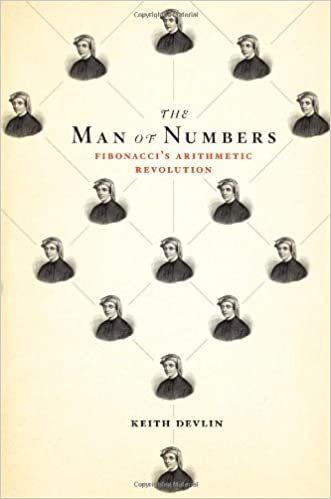Visitors to the Camposanto, the sacred burial ground of Pisa, so sadly damaged by Allied bombers in the Second World War, find all manner of monuments lining the walls, from Roman sarcophagi to statues of the illustrious citizens of later centuries. One of these, recently cleaned up and restored, dates from 1863 and it commemorates one of Pisa’s heroes, the mathematician Leonardo da Pisa, often known as Fibonacci (a corruption of Filius Bonacci, the son of Guiglielmo Bonacci). Although no contemporary depiction of him survives, he springs from the sculptor’s imagination with classical features, a cowled head and a long tunic. He lived from around 1170 to 1250.

Fibonacci is best known today for his famous mathematical puzzle of the breeding rabbits. Shut up a pair of rabbits in an enclosure, assume that the doe will give birth to a pair of baby rabbits every month and that these two will be up and breeding a pair a month within a month. Genetically impossible of course, but the numbers can be built up into a sequence of 1, 1, 2, 3, 5, 8, 13, 21, 34 and so on. These ‘Fibonacci’ numbers reappear in all kinds of strange places, not least as the typical number of petals in a flower.
Fibonacci was not the first to work out this sequence and Keith Devlin is not nearly as interested in it as in Fibonacci’s contribution to the commercial revolution of 13th and 14th century Italy. These years were the age of trading breakthroughs for the Italians as they captured new routes and filled them with finished grain in return for raw materials. The Venetians strengthened their position immensely after the Fourth Crusade of 1204 had allowed them to lay their hands on ports across the Mediterranean. Florence expanded fast after 1200. Yet there was a bottleneck in the commercial background. There were experts who could manipulate an abacus as quickly as one might operate a calculator today, but the final answers were always written in Roman numerals. As soon as complex issues arose, concerning how to divide profits or change money between coins of different alloys, the system just broke down. The Arab traders, on the other hand, were using a system they had adopted from India. It comprised nine numbers, each with a single-digit symbol, 8 for VIII, for instance, and, crucially, a zero, which was recognized as a number in its own right. The man who transferred the system into Italy was, Devlin argues in this entertaining book, none other than Fibonacci.
Fibonacci’s father had been posted by Pisa to the port of Bugia, in modern Algeria, where he acted as the Pisan go-between with the Berbers. Leonardo, still a boy, went with him. He must have picked up Arabic, as he tells how he talked to merchants from Egypt and Syria, and he soon grasped the superiority of their calculations and became obsessed by them. In 1202 he published a mammoth 600-page manuscript, the Liber Abaci, ‘The Book of Calculation’. It was the first time that the system had been spelled out fully and aimed directly at Italian merchants. Everything from how to divide profits and measure land to dealing in currency exchange was covered with a myriad examples to show how each kind of calculation could be made.
No copies of the 1202 manuscript survive but there are some of the second edition of 1228. By this time, Fibonacci was famous. He had been summoned to meet the formidable Holy Roman Emperor, Frederick II, who had set him three problems which he triumphantly solved. He wrote up the answers in his Liber quadratorum and this work has helped confirm him as the finest mathematician of the Middle Ages.
By the end of the 13th century there were a mass of simpler books of calculation and schools were teaching the system. In Florence in 1343, between 1,000 and 1,200 boys were working in abbaci schools. Until recently, however, historians have not been able to link Fibonacci directly to the introduction of the new system. The workbooks used by students and merchants did not appear to overlap with anything in Liber Abaci. Perhaps the system had come in at a less erudite level and slowly infiltrated the Italian cities. Yet later writers often named Fibonacci as the man who introduced arithmetic and algebra to Europe.
Devlin shows how the question has been resolved. Fibonacci must have realized that the huge manuscript of the Liber Abaci and another text he wrote for merchants on geometry, which was scarcely less large, were too much for the ordinary merchant to master. So he wrote a much shorter and simple text, now lost, and this can now be directly linked to the manuals to be found in the schools some decades later. Fibonacci was truly ‘the man of numbers’, both at a sophisticated level in algebra, but on the market floor.
This is a short book on a man about whom almost nothing is known. Fibonacci sometimes called himself Bigallo, perhaps a Tuscan dialect word for traveller, and he certainly knew his way around the cosmopolitan Mediterranean world of the 13th century. It was perhaps inevitable that the Hindu-Arabic system would have come to Italy in time—it was simply too useful in a complex trading world—but Devlin has certainly shown that Fibonacci deserves the credit for setting in all in motion. This is a readable and enjoyable book and I actually understood the maths!
Reviewed by Charles Freeman, historical consultant to the Blue Guides and author of Sites of Antiquity: 50 Sites that Explain the Classical World.






